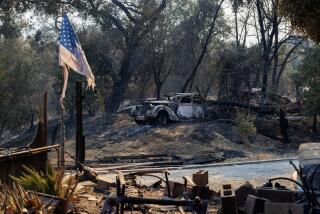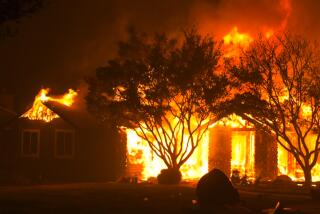Insurer Fans Debate Over Association Fire Fee : Woodland Hills: Tiny Crusader Insurance Co. protests Fair Plan’s assessment policy, saying firms are penalized for business in the inner city.
Facing claims of $150 million from the recent Southland wildfires, the California Fair Plan Assn. has assessed its 280 insurance-company members amounts ranging from $9,000 to $17 million, based largely on firms’ market share in the state.
But one disgruntled member, tiny Crusader Insurance Co. of Woodland Hills, is contesting its $325,000 bill and leading a fight to change Fair Plan’s assessment policy, which Crusader calls unfair.
The Fair Plan is an industry-sponsored insurer of last resort and provides coverage to homes and businesses in brush-fire areas and the inner city. The association suffered the biggest loss of any insurer from the recent fires, forcing the organization to make a cash call for the first time in its 25-year history.
Crusader’s complaint focuses on the Fair Plan’s practice of giving “credits” to member companies that voluntarily insure properties in brush-fire zones. Such credits are intended to provide incentives for insurers to write in brush-fire areas by reducing a company’s share of costs in case Fair Plan must make a cash call. But insurers don’t get credits for writing in the inner city.
“The system isn’t fair,” said Cary Cheldin, executive vice president at Crusader, a small insurer that does relatively big business in South-Central Los Angeles. “There’s a big incentive to sell insurance in brush areas, but not in the inner city.”
In the most dramatic example of how the credit system works, State Farm’s recent bill from the Fair Plan was cut by 42%, to $13 million from $22.5 million, because of the many credits State Farm got for its high-volume business in brush-fire areas. What’s cut from State Farm’s assessment was then spread to other insurers, including Crusader.
The biggest Fair Plan bills went to Allstate Insurance Co. and Farmers Insurance Group; each was assessed about $17 million, they said. Two other Woodland Hills-based insurers--20th Century Insurance and TIG, formerly called Transamerica Insurance Group--said their Fair Plan bills came to $2.6 million and $3.8 million, respectively.
The Fair Plan bills were on top of the $4.5 million in fire claims 20th Century Insurance received from its policyholders, and $4.8 million for TIG. After the Fair Plan, insurers receiving the biggest fire claims were State Farm ($135 million), Allstate ($81 million) and Farmers Insurance Group ($72 million).
Still, Allstate said its Fair Plan bill was reduced significantly by brush-area credits, although it wouldn’t say by exactly how much. “It’s nice and I’m glad we have it,” said Dick Donegan, Allstate’s regional underwriting manager.
Crusader had virtually no losses from the recent fires because it has few policyholders in brush areas. But Crusader is a major insurer of businesses in the inner city, and it says the Fair Plan should get rid of the credits altogether or extend them to companies for writing in the urban core.
Crusader, which has less than $30 million in annual revenue, was hit with $21 million in claims from last year’s riots. That wiped out half of its equity, and Crusader has since dropped half of its 2,000 policyholders--mainly hard-to-insure mom-and-pop businesses in South-Central--who had property coverage. An additional 2,000 inner-city businesses have liability coverage through Crusader.
Big companies argue that they also write a lot of insurance in urban areas, although residents of the inner city complain about the lack of affordable insurance in their neighborhoods. Crusader and others say it’s unfair that the Fair Plan gives brush-area insurers credits when Crusader is taking on considerable risk as well by insuring businesses in the inner city.
After last year’s riots, the Fair Plan received claims of about $40 million from its policyholders. But companies doing brush-area insurance then also got reduced assessments for the riot damage payout--although there were no riot-related bills sent to member companies because of leftover money from earlier years.
Crusader’s assessment from the Fair Plan for riot losses last year came to $82,000. Cheldin is now asking the Fair Plan to credit that amount to Crusader’s account, and he says its recent $325,000 fire-claims assessment should be waived because of the company’s large writings in the city.
If Crusader got credits for writing in the inner city as others now do for the brush areas, Cheldin says, “our assessment would be nothing.”
Fair Plan officials said they would consider Cheldin’s request, but they defended the organization’s operations. The association can’t give credits to everyone, said Stuart Wilkinson, Fair Plan’s general manager. “It’s like everybody taking an orange crate to the parade to get a better view.” Wilkinson added that Crusader was the only company to voice complaints about the brush-area credits.
But some other mainly small insurers said they supported Crusader. “Unfortunately, we don’t have much of a voice because the Fair Plan is made up of the top 10 writers in the state,” said Rupert Hall, vice president of Stockton-based Golden Bear Insurance Co., which has 2,000 policyholders in the urban area.
The Fair Plan is actually run by a committee made up of nine insurance company representatives, who are voted in by the plan’s 280 members. But each member’s votes are weighted by its market share, so the nine board members are invariably from large companies.
The Fair Plan declined to provide details of the credit system or its finances. But in its annual report sent to member companies last week, as of Sept. 30 the Fair Plan had 26,671 policyholders in brush areas--accounting for a majority of residents who live in designated brush-fire zones in California. The plan also has 89,248 policies in force in the urban areas. Its overall amount of coverage exceeds $19 billion.
Until the recent fires, analysts say, few looked hard at the Fair Plan’s credit system or other issues because the association always turned a profit, which it then distributed to members, also on a market-share basis.
But with the the recent wildfires have come questions about the Fair Plan’s relatively low premium rates for high-risk brush area dwellings. Insurance Commissioner John Garamendi, who has the final say in the Fair Plan’s operations, has said he would soon hold hearings to look into that issue, and Garamendi is now likely also to review questions about the plan’s method of assessing members.
Wilkinson, Fair Plan’s general manager, stressed that the association gives brush-area credits because it is specifically written in the state code. But the law also states that the Fair Plan, if it wanted to, could provide credits for voluntary writings in other areas, including the inner city.
Richard Wadley of State Farm, currently a member of Fair Plan’s governing body, said Crusader’s request for credits for inner-city writing was “perfectly valid.” And he said the panel would address Crusader’s complaint at the next board meeting in January.
But other board members, including representatives of Allstate and Farmers Insurance Group, suggested that Crusader’s fight could be a difficult one.
More to Read
Sign up for Essential California
The most important California stories and recommendations in your inbox every morning.
You may occasionally receive promotional content from the Los Angeles Times.











